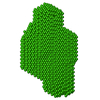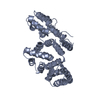+Search query
-Structure paper
| Title | Conformational analysis of a genetically encoded FRET biosensor by SAXS. |
|---|---|
| Journal, issue, pages | Biophys J, Vol. 102, Issue 12, Page 2866-2875, Year 2012 |
| Publish date | Jun 20, 2012 |
 Authors Authors | Haydyn D T Mertens / Alen Piljić / Carsten Schultz / Dmitri I Svergun /  |
| PubMed Abstract | Genetically encoded FRET (Foerster resonance energy transfer) sensors are exciting tools in modern cell biology. Changes in the conformation of a sensor lead to an altered emission ratio and provide ...Genetically encoded FRET (Foerster resonance energy transfer) sensors are exciting tools in modern cell biology. Changes in the conformation of a sensor lead to an altered emission ratio and provide the means to determine both temporal and spatial changes in target molecules, as well as the activity of enzymes. FRET sensors are widely used to follow phosphorylation events and to monitor the effects of elevated calcium levels. Here, we report for the first time, to our knowledge, on the analysis of the conformational changes involved in sensor function at low resolution using a combination of in vitro and in cellulo FRET measurements and small-angle scattering of x rays (SAXS). The large and dynamic structural rearrangements involved in the modification of the calcium- and phosphorylation-sensitive probe CYNEX4 are comprehensively characterized. It is demonstrated that the synergistic use of SAXS and FRET methods allows one to resolve the ambiguities arising due to the rotation of the sensor molecules and the flexibility of the probe. |
 External links External links |  Biophys J / Biophys J /  PubMed:22735537 / PubMed:22735537 /  PubMed Central PubMed Central |
| Methods | SAS (X-ray synchrotron) |
| Structure data |  SASDAE5:  SASDAF5:  SASDAJ5: |
| Source |
|
 Movie
Movie Controller
Controller Structure viewers
Structure viewers About Yorodumi Papers
About Yorodumi Papers



 Homo sapiens (human)
Homo sapiens (human)